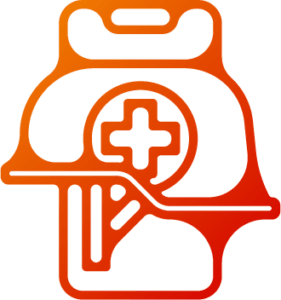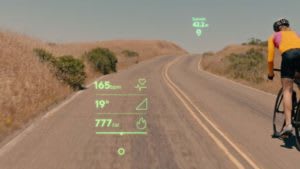Story by Lauren Lively.
(Part four of a five-part series on how augmented reality is changing every industry)
We already know from previous articles that augmented reality (AR) is impacting every industry. From shopping to education, there seems to be no end to what AR can improve.
So why not take AR to the operating table?
Because AR takes your real-life environment and adds additional elements to it, this technology is changing the way doctors diagnose, military medics make medical decisions, and adding life-saving technology into the pockets of everyone.
Training, Diagnosis, Treatment
For centuries, people have imagined the extraordinary things technology could do to help improve daily life.
For example, the Jetsons aired an episode where George swallowed a small robot that performs an internal checkup and shows the doctor his insides.
This isn’t too different from what AR is currently doing.
With the help of programs like Proximie, doctors can show patients their health problems and explain step-by-step treatment plans with 3D models.
AR also allows physicians to view data without having to touch anything. This is important because physicians have to keep the field sterilized, and this eliminates the need to use a computer keyboard or mouse.
As if treatment plans and sterilization aren’t enough of a reason for physicians to use AR, this technology is also a smart way to help in physician training.
AR Training
Training with AR creates a learning environment where the pressure is lower and the learning is more hands-on.
With AR/VR programs like Osso, students are able to perform an ankle replacement from beginning to end without having to perform on a real person and without the assistance of another doctor.
AR isn’t only helping surgical staff. This technology is assisting nurses in finding veins in their patients.
Because finding veins in children and the elderly can sometimes be a trying task for nurses, new technology has been made to find veins with ease.
Accuvein scans the patient’s arm using an infrared laser and then projects an image of the veins back into the patient’s arm. And because the device is small and lightweight, it makes for an ideal device to use for each patient.
According to Accuvein, 40% of IVs miss the vein on the first stick. This device improves the likelihood of a successful IV by 3.5 times and reduces the need to call for assistance by 45%.
While the benefits behind AR are growing, some hospitals aren’t adapting because of how long scanning and digitizing everything can take.
You would also have to train the doctors how to use the technology, which takes a lot of time and extra money.
AR Meets Specific Military Needs
The U.S Army just invested in a $750,000 development contract with MedCognition’s PerSim AR system which provides training for combat casualty care. This program simulates realistic battlefield wounds and mass casualty injuries.
The technology is based on a system called PerSim, which is used as a training program for paramedics, firefighters, and police.

(Left) Realistic AR patient (Right) Training Paramedic. Image courtesy of PerSim.
Realistic scenarios like respiratory distress, strokes, and trauma are given to prepare staff for how patients will look and act.
This AR technology is helping train the military in battlefield care, battlefield injuries, and mass casualty injuries.
Battlefield Care
Because military training is taught in a classroom, AR will help immerse them into real life military medicine and battlefield care. The program is still being developed and is expected to launch within the next few months.
One AR technology is already providing a valuable battlefield service that other devices have yet to master.
Portable ultrasound technology uses high frequency sound waves to find veins, blood in the abdomen, fractures, collapsed lungs, nerve bundles, and babies.
Having a portable ultrasound is ideal because the device weighs less than five pounds and is battery operated. They also cost $40,000 which is about the third of the price of a full-sized X-ray machine.
Portable ultrasounds are also being used in ambulances and developing countries.
With the help of the portable ultrasound, military medics are able to better assist combat wounds. But what happens when you have limited resources and too many soldiers have similar injuries?
Jerome Buller, who leads the U.S. Army Institute of Surgical Research, told Defense One a scenario where AR technology is crucial for the best care.
“Let’s say you and your fellow soldier have the same injury. Looks the same, pools of blood are the same. You may compensate [as in, survive injury] far better than she can, or vice versa. And if I only have two packets of blood, who do I give it to?”
This technology is currently being developed to make sure military medics don’t have to rely solely on their intuition.
Along with saving the most amount of lives, the technology could also improve the mental being of the medics. This is because the technology is the one helping guide their decisions on who is best to assist.
AR Assists More Than Just Trained Professionals
Having these AR devices are helping those in the medical field. But what can AR do for everyone else?
As mentioned in a previous article, AR can be a great learning hub for anyone at any age. If you want to learn about your anatomy, there are a few apps that use AR to make learning easier.
Visible Body not only lets you learn about specific body parts, but Visible Body’s AR technology shows you what your anatomy looks like as you move around.
This feature is different from other AR apps because your body is the marker.
As well as helping students learn, AR technology is helping the visually impaired see.
Cognitive Augmented Reality Assistant, or CARA, helps the blind navigate by telling the user what objects they’re approaching. This reduces the amount of times the user will bump into objects, walls, or tables.
CARA puts a “3D mesh” on top of everything in a space and detects what each object is. Objects will call out to you and the pitch of the voice varies by how close or far you are to the object.
This Technology Helps In Many Different Ways.
You can navigate through this virtual guide by having the program say “follow me.” You follow the voice to your destination while it calls out objects, so you don’t bump into anything.
Have it call out objects in a space from left to right so you have an idea of the layout of the room and where everything is.
3.Spotlight mode calls out objects that are right in front of you.
As well as helping the visually impaired, new technology will soon come out to assist those who wear contact lenses.
MOJO Lens is a smart contact lens that puts AR on top of your vision.
These lenses let you see notifications, health data, weather and more, without ever having to look down at your phone.
These contact lenses were designed by optometrists, technologists, and medical experts.
The lenses connect wirelessly to your phone and pulls data from the cloud. The battery life is one day and charges when you take them out to sleep.
But AR doesn’t just save your life if you’re sick or visually-impaired. It can save your life from a heart attack by locating local defibrillators
By having a database where users can also add new locations, this app shows where the closest defibrillators are and how long it would take to access them.
This life-saving technology has been proven to be so useful that the Dutch Red Cross integrated it into their app.
Although you should call emergency services if a situation arises, this technology is useful in the time it takes for them to get to your location.
What’s Next For AR?
Augmented reality is approaching every market and has elements that can be helpful for every situation.
If you’re interested in more articles like this one, view other articles in this series. Or, let us know by reaching out.









Top comments (0)